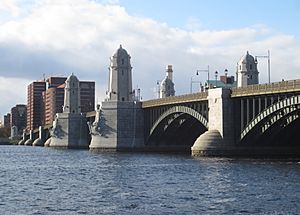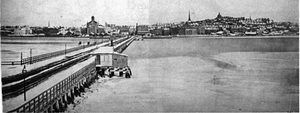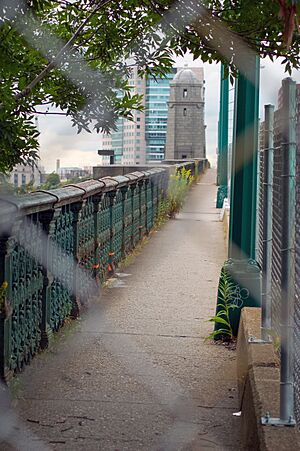Longfellow Bridge facts for kids
Quick facts for kids Longfellow Bridge |
|
|---|---|

Longfellow Bridge viewed from the Boston end in 2019
|
|
| Coordinates | 42°21′42″N 71°04′31″W / 42.361635°N 71.07541°W |
| Carries | |
| Crosses | Charles River |
| Locale | Boston, Massachusetts to Cambridge, Massachusetts |
| Maintained by | Massachusetts Department of Transportation |
| Characteristics | |
| Design | Steel rib arch bridge |
| Total length | 1,767.5 feet (538.7 m) |
| Width | 105 feet (32 m) |
| Longest span | 188.5 feet (57.5 m) |
| History | |
| Construction begin | July 1900 |
| Opened | August 3, 1906 |
| Rebuilt | 2013–2018 |
| Statistics | |
| Daily traffic | 28,600 cars and 90,000 mass-transit passengers |
The Longfellow Bridge is a famous bridge that crosses the Charles River in Massachusetts. It connects the Beacon Hill area of Boston with the Kendall Square area in Cambridge, Massachusetts. This important bridge carries Massachusetts Route 3 for cars, the MBTA Red Line subway, and paths for bikes and people walking.
Many people know the bridge by other names. It was first called the Cambridge Bridge. Before that, an older bridge in the same spot was known as the West Boston Bridge. Locals also sometimes call it the "Salt-and-Pepper Bridge" because its central towers look like salt and pepper shakers.
The Massachusetts Department of Transportation (MassDOT) is in charge of keeping the bridge safe and well-maintained. Every weekday, about 28,600 cars and 90,000 subway passengers use the Longfellow Bridge. The MBTA subway's Charles/MGH station is right at the Boston end of the bridge.
Contents
Bridge Design and Features
The Longfellow Bridge is special because it carries both trains and cars. It is about 105 feet (32 m) wide and 1,767 feet (539 m) long. If you include the ramps leading up to it, the bridge is almost half a mile long!
The bridge has eleven steel arches. These arches are supported by ten strong stone piers and two large end supports. The arches are different sizes, with the longest one in the middle measuring about 188 feet (57 m).
The two biggest piers in the middle of the river have four decorative stone towers. These towers are carved with the front parts of Viking ships. This design is a nod to an old story about Leif Eriksson, a Viking explorer, possibly sailing up the Charles River around the year 1000. A Harvard professor named Eben Horsford helped make this story popular a long time ago. The piers also show the official symbols of Boston and Cambridge.
When you are on the Longfellow Bridge, you get an amazing view of the Boston skyline. Many people say that riding the Red Line over the bridge offers a beautiful look at the city.
A Look Back: The Bridge's History
The very first way to cross the river at this spot was by ferry in the 1630s. Later, in 1793, a group of people built the West Boston Bridge. This was a toll bridge, meaning you had to pay to cross it. At that time, there weren't many buildings in East Cambridge. The new bridge helped East Cambridge grow, with new streets and land being created from swamps.
The West Boston Bridge became free to use in 1858. It also became important for public transportation. The first horsecar line in Boston, which was like a trolley pulled by horses, started crossing this bridge in 1856. This line connected Bowdoin Square and Harvard Square. Eventually, these horsecar lines became electric.
Building the New Cambridge Bridge
By 1898, a new, bigger bridge was needed for all the growing traffic, including elevated trains. A special group called the Cambridge Bridge Commission was formed to build it. Engineers and architects traveled to Europe to study famous bridges there. They wanted to build a beautiful and strong bridge.
Even though rules usually required bridges to have a part that could open for boats (a draw bridge), it was decided that a bridge without a draw would be better and cheaper. After getting special permission from the government, construction began in July 1900. The bridge opened for traffic in August 1906 and was officially celebrated in July 1907.
Renaming the Bridge
In 1927, the Cambridge Bridge was renamed the Longfellow Bridge. This was done to honor Henry Wadsworth Longfellow, a famous poet. He had written a poem called "The Bridge" in 1845 about the older West Boston Bridge.
Changes for Pedestrians and Trains
The bridge has stairs at both ends for people walking. Originally, these stairs led right to the riverbanks. But in the 1950s, a highway called Storrow Drive was built on the Boston side. This moved the riverbank, so now the stairs on the Boston side lead to small areas cut off from the river. To reach the Charles River Esplanade by the river, people now use the Frances Appleton Bridge, a special pedestrian bridge nearby.
When the new bridge was built, it included tracks for streetcars and an empty space in the middle. In 1912, the Cambridge–Dorchester line (which is now the Red Line subway) started using the middle tracks. This greatly reduced the number of streetcars on the bridge. By 1925, buses replaced the last streetcar route over the bridge. The Charles/MGH station opened in 1932, making it easy for people to get to the West End and Massachusetts General Hospital.
Keeping the Bridge Strong: Repairs and Reconstruction
Like many old bridges, the Longfellow Bridge eventually needed a lot of work. Between 1907 and 2011, there were only a few small repair projects.
In 2008, parts of the bridge were in such bad shape that a sidewalk and a traffic lane had to be closed. Subway trains had to go very slowly, and people were not allowed on the bridge for Fourth of July fireworks because of safety worries. This led to a big plan to fix the bridge.
Major Reconstruction Project

A huge project costing $255 million began in the summer of 2013. The goal was to replace old parts of the bridge and bring back its original historic look. This project involved many weekend shutdowns of the Red Line subway and temporary changes to traffic lanes.
The engineers and architects worked hard to make the bridge stronger and safer, while also keeping its beautiful historic design. A big part of the work involved carefully taking apart, cleaning, fixing, and putting back together the tall towers that stand over the river.
The project was supposed to finish in 2016, but it took longer because some of the historic repairs needed older building methods. To speed things up, the outbound side of the bridge (from Boston to Cambridge) was completely closed to all traffic in August 2016.
After years of work, the Longfellow Bridge fully reopened on May 31, 2018. Some smaller parts of the project, like replacing a pedestrian bridge over Storrow Drive, were finished later that year. The total cost of this major rebuilding project was about $306.6 million.
See also
- List of bridges documented by the Historic American Engineering Record in Massachusetts






